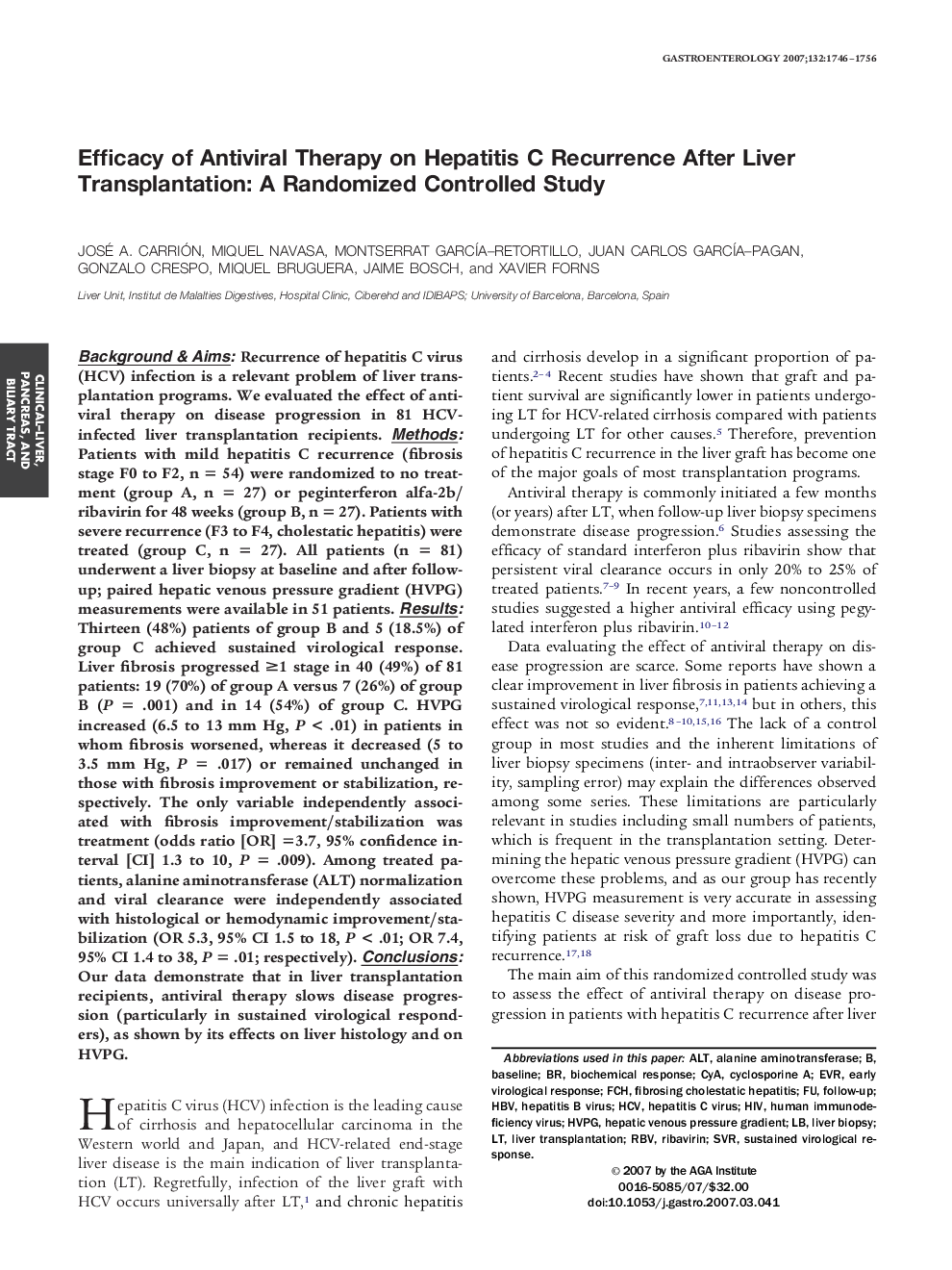| کد مقاله | کد نشریه | سال انتشار | مقاله انگلیسی | نسخه تمام متن |
|---|---|---|---|---|
| 6097072 | 1209900 | 2007 | 11 صفحه PDF | دانلود رایگان |
عنوان انگلیسی مقاله ISI
Efficacy of Antiviral Therapy on Hepatitis C Recurrence After Liver Transplantation: A Randomized Controlled Study
دانلود مقاله + سفارش ترجمه
دانلود مقاله ISI انگلیسی
رایگان برای ایرانیان
کلمات کلیدی
CyAFCHEVRSVRHVPGALTRBVAlanine aminotransferase - آلانین آمینوترانسفرازLiver biopsy - بیوپسی کبد، نمونه برداری از کبدFollow-up - تماس با بیمار پس از تشخیص یا درمانbaseline - خط مقدمRibavirin - ریباویرین Cyclosporine A - سیکلوسپورینAHepatic venous pressure gradient - شیب فشار خون وریدیHBV - هپاتیت بHepatitis C virus - هپاتیت سیHCV - هپاتیت سیfibrosing cholestatic hepatitis - هپاتیت کلستاتیک فیبروز استhuman immunodeficiency virus - ویروس نقص ایمنی انسانیHIV - ویروس نقص ایمنی انسانی hepatitis B virus - ویروس هپاتیت بیBiochemical response - پاسخ بیوشیمیاییsustained virological response - پاسخ ویروسی بالقوهearly virological response - پاسخ ویروسی زودرسLiver transplantation - پیوند کبد
موضوعات مرتبط
علوم پزشکی و سلامت
پزشکی و دندانپزشکی
بیماریهای گوارشی
پیش نمایش صفحه اول مقاله

چکیده انگلیسی
Background & Aims: Recurrence of hepatitis C virus (HCV) infection is a relevant problem of liver transplantation programs. We evaluated the effect of antiviral therapy on disease progression in 81 HCV-infected liver transplantation recipients. Methods: Patients with mild hepatitis C recurrence (fibrosis stage F0 to F2, n = 54) were randomized to no treatment (group A, n = 27) or peginterferon alfa-2b/ribavirin for 48 weeks (group B, n = 27). Patients with severe recurrence (F3 to F4, cholestatic hepatitis) were treated (group C, n = 27). All patients (n = 81) underwent a liver biopsy at baseline and after follow-up; paired hepatic venous pressure gradient (HVPG) measurements were available in 51 patients. Results: Thirteen (48%) patients of group B and 5 (18.5%) of group C achieved sustained virological response. Liver fibrosis progressed â¥1 stage in 40 (49%) of 81 patients: 19 (70%) of group A versus 7 (26%) of group B (P = .001) and in 14 (54%) of group C. HVPG increased (6.5 to 13 mm Hg, P < .01) in patients in whom fibrosis worsened, whereas it decreased (5 to 3.5 mm Hg, P = .017) or remained unchanged in those with fibrosis improvement or stabilization, respectively. The only variable independently associated with fibrosis improvement/stabilization was treatment (odds ratio [OR] =3.7, 95% confidence interval [CI] 1.3 to 10, P = .009). Among treated patients, alanine aminotransferase (ALT) normalization and viral clearance were independently associated with histological or hemodynamic improvement/stabilization (OR 5.3, 95% CI 1.5 to 18, P < .01; OR 7.4, 95% CI 1.4 to 38, P = .01; respectively). Conclusions: Our data demonstrate that in liver transplantation recipients, antiviral therapy slows disease progression (particularly in sustained virological responders), as shown by its effects on liver histology and on HVPG.
ناشر
Database: Elsevier - ScienceDirect (ساینس دایرکت)
Journal: Gastroenterology - Volume 132, Issue 5, May 2007, Pages 1746-1756
Journal: Gastroenterology - Volume 132, Issue 5, May 2007, Pages 1746-1756
نویسندگان
José A. Carrión, Miquel Navasa, Montserrat GarcÃa-Retortillo, Juan Carlos GarcÃa-Pagan, Gonzalo Crespo, Miquel Bruguera, Jaime Bosch, Xavier Forns,